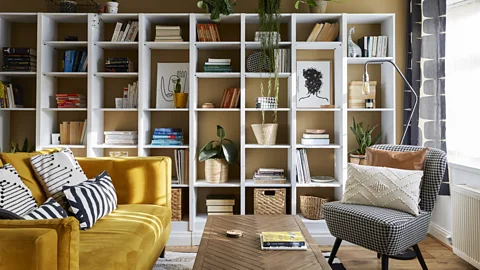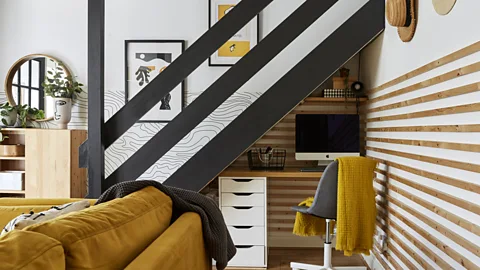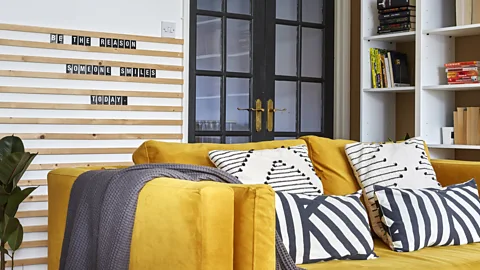How chronic renters are reshaping the homeware industry
 Kasia Fiszer Photography
Kasia Fiszer PhotographyHome ownership is a distant dream for many millennials – but they still want stylish, personalised rental homes. Their ambitions are changing the homeware industry.
Have you recently become a self-proclaimed houseplant parent? Seen your social media feed flood with millennial pink kitchenware and bookshelves organised by colour? Or browsed your favourite clothing brand and found that they’ve started up a new homeware department full of brightly patterned throws and rose gold cutlery?
While once our clothes were the ultimate signifier of our personal style, our houses are increasingly becoming things to be showcased. Search #interiordesign on Instagram and you’ll discover almost 90 million perfectly curated posts of colour-coordinated bedrooms and bright-white painted living rooms. Private spheres of our lives once only shared with our closest friends and the occasional house guest are now designed for public consumption.
“Everyone is becoming more concerned with how their homes look,” says Alessandra Wood, a design historian and vice-president of style at Modsy. “We’ve seen affordable furniture become much more stylish and on trend. The opening price point range is no longer sad and dumpy, but actually driving many blogger and influencer trends – much like fast fashion.”
Yet while the Instagram aesthetic might have inspired new interest in home decoration, fewer and fewer of us are personalising properties that we can call our own. Soaring house prices and stagnating wages have led to a bloated rental market in Europe and the US, with just 37% of 24-35 years old Americans owning their home (compared to 43% in 2005). In the UK this is even lower, with just 34% of people in the same age group owning property (compared to 55% in 1996).
It is clear that millennials and Gen Z are now renting at record rates, yet the appetite to make a house a home remains equally high. While picking out the perfect shade for the living room or putting down new carpets might have been important interior choices for their parents, young people are increasingly finding more temporary solutions to the challenge of making a rental home #interiorinspo worthy without falling foul of their landlords.
Removable chic, rental plants
“A house is a home whether it’s rented or not,” says renter Chelsey Brown, 27, who resides in New York. “Many people are reluctant to design their spaces due to renter restrictions, but I don’t allow any rental I live in to confine me to what I can or can’t do. For example, I’ve always wanted wall panelling in my home and so I figured out a way to install temporary wainscoting. Additionally, I’ve always dreamed of having a white, marble kitchen and I achieved that look in my own rental by using removable, peel-and-stick products.”
For some young renters, personalising a home can come down to affordable, stylish additions. Houseplant sales have surged almost 50% in the US over the last three years, and mass market retailers such as Zara, ASOS and H&M have all recently launched homeware ranges, focusing largely on smaller items like vases, cushions and candles that are easy to incorporate into an already furnished space. Brown is currently working on a range of removable products for renters, such as stick-on floor tiles and removable back splashes inspired by her own experience of overhauling a rental property.
 Kasia Fiszer Photography
Kasia Fiszer Photography“Until recent years, renting used to be just a step in the process, but now it’s the beginning and endgame for many people,” she explains. “I want to show people that you can create your dream space in a rental home.”
Some businesses are now even offering to equip homes with pay-per-month furniture, with everything from sofas to houseplants up for rent. This gives landlords the opportunity to entice tenants with on-trend interiors rather than battered sofas and mismatched furnishings, as well as offering renters the opportunity to customise their own temporary space.
“Rental companies have been reborn as hip, stylish alternatives to purchasing furniture for a temporary space,” explains Wood. “These companies target millennials who have anxiety about committing to goods.”
California-based Fashion Furniture Rental is one such business offering furniture, electronics and homeware on a lease basis. Although the company has traditionally helped outfit large-scale accommodation projects, as well as students and those in the military, it is increasingly experiencing interest from young renters.
“We are seeing a trend of individuals, specifically millennials and Gen Z, looking for new life experiences rather than the desire to stay put in one place,” says Abra Landau, a marketing manager for Fashion Furniture. “With that mindset, the idea of renting furniture when you need it and returning it to the company when you’re ready to move on to your new adventure is incredibly appealing.”
As their market shifts towards more style-focused tenants, companies that offer rental items are keen to adapt their model and items on offer accordingly.
“I think that in all industries personalised yet accessible, affordable services are all the rage,” says Rhiannon Smith, a spokesperson for plant rental company The Plant Library. “People want things to feel good, without having to think too much about it or pay too much for it. I'd anticipate it's a sector that will be very popular and continue to grow.”
The risks of investing
Renting the contents of your home might seem like one of the pricier ways of personalising it, but it is increasingly a solution for style-conscious young renters who don’t see the value in investing in permanent pieces for a rental property.
“Once you’ve paid your deposit, rent and agency fees, there isn’t much money left over for buying furniture,” says Medina Grillo, a 31-year-old renter from the UK. “Lots of the furniture in my first rented home was cheap, mismatched purchases off eBay and hand-me-downs from family and friends. Renting furniture really would have made it.”
 Kasia Fiszer Photography
Kasia Fiszer PhotographyGrillo has managed to customise her home with pops of colour and quirky patterns, sharing her enviably striking rental property on social media.
“I think that because I rent, I have to constantly remind myself not to get too carried away with some of my decorating ideas,” she says. “The biggest challenge for renters is the fear of doing something that could cause you to lose your deposit – which is especially the case when you privately rent and there are less protections than in social housing. Some renters may also feel reluctant to decorate or invest in a home that isn’t technically theirs, thinking that the money might be better used for a deposit on a house.”
Grillo experienced the downside of investing time and money in a property only to fall victim to the insecure nature of the letting market, when her landlord decided to sell her previous home. “We had lived there for almost three years and had created so many happy memories. Having to move was really upsetting and we found the process of looking for a new property with a young child incredibly stressful.”
For some renters the impact of being forced to vacate a property that they have redesigned is even more significant. Amina Mucciolo, whose rainbow-themed rental Cloudland went viral in 2017, was threatened with eviction from her colourful apartment in 2019, derailing both her home and the livelihood that she had built off the back of it.
In their struggle to find permanence, Millennial and Gen Z renters are creating a sense of home in increasingly creative ways. Many are unwilling to compromise on comfort and aesthetic sensibility – and yet the temporary nature of the interiors that they are choosing reflects a sense of transience in their lives. With homeownership a distant dream for most of them, companies will continue to adapt to the many ways in which this is changing the homeware industry.
“We're living in a moment where the outside world is scary and seems to get scarier by the week,” says Wood. “Our home is our sanctuary, our private space that protects us from the outside world, and can provide this type of psychological safety. People want to invest more resources in making their homes beautifully designed and a reflection of themselves. They may use affordable design services, or go a DIY route using Instagram and Pinterest as inspiration. But whatever route they take will likely reflect our current culture's love for well-designed things.”
